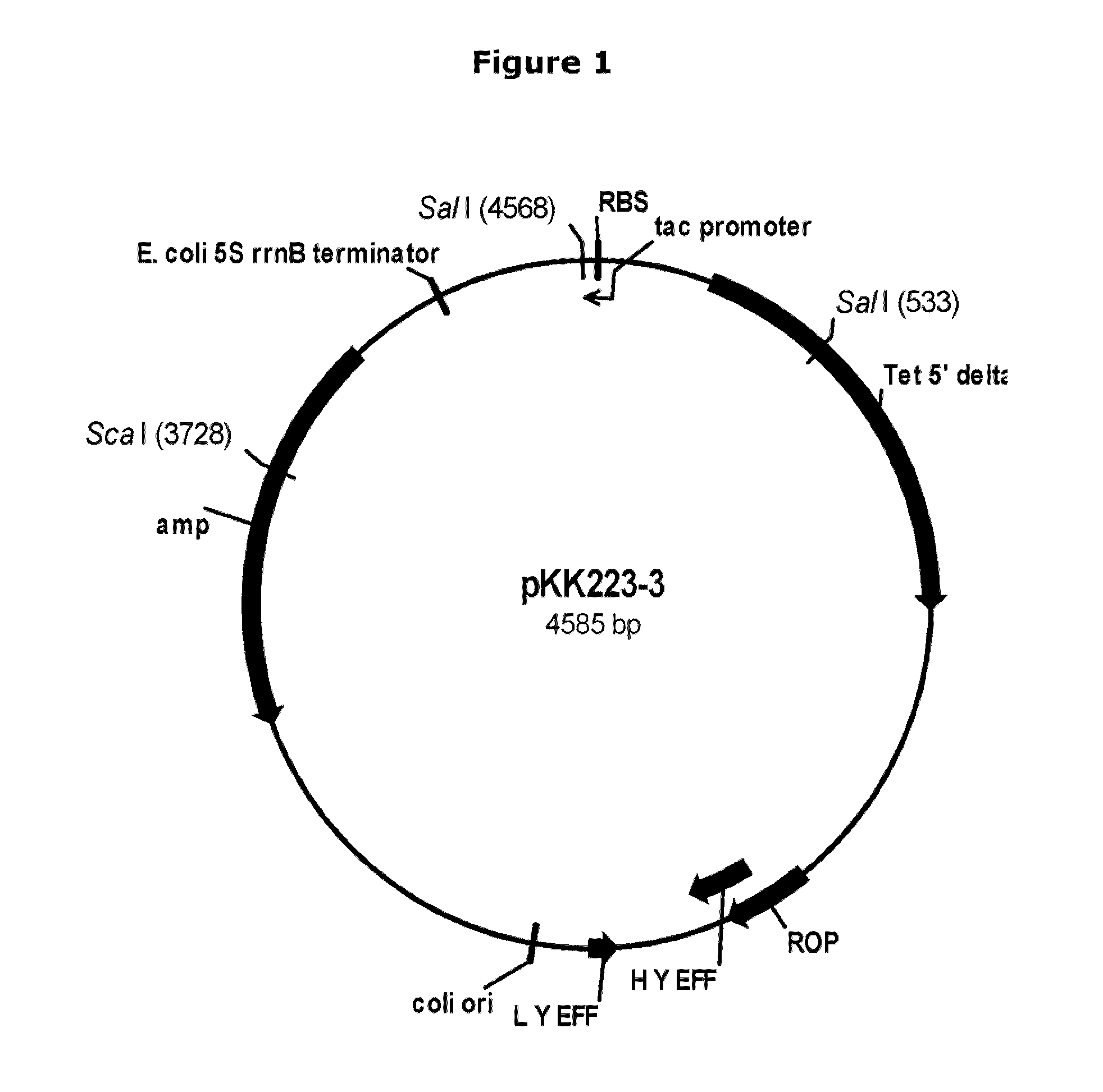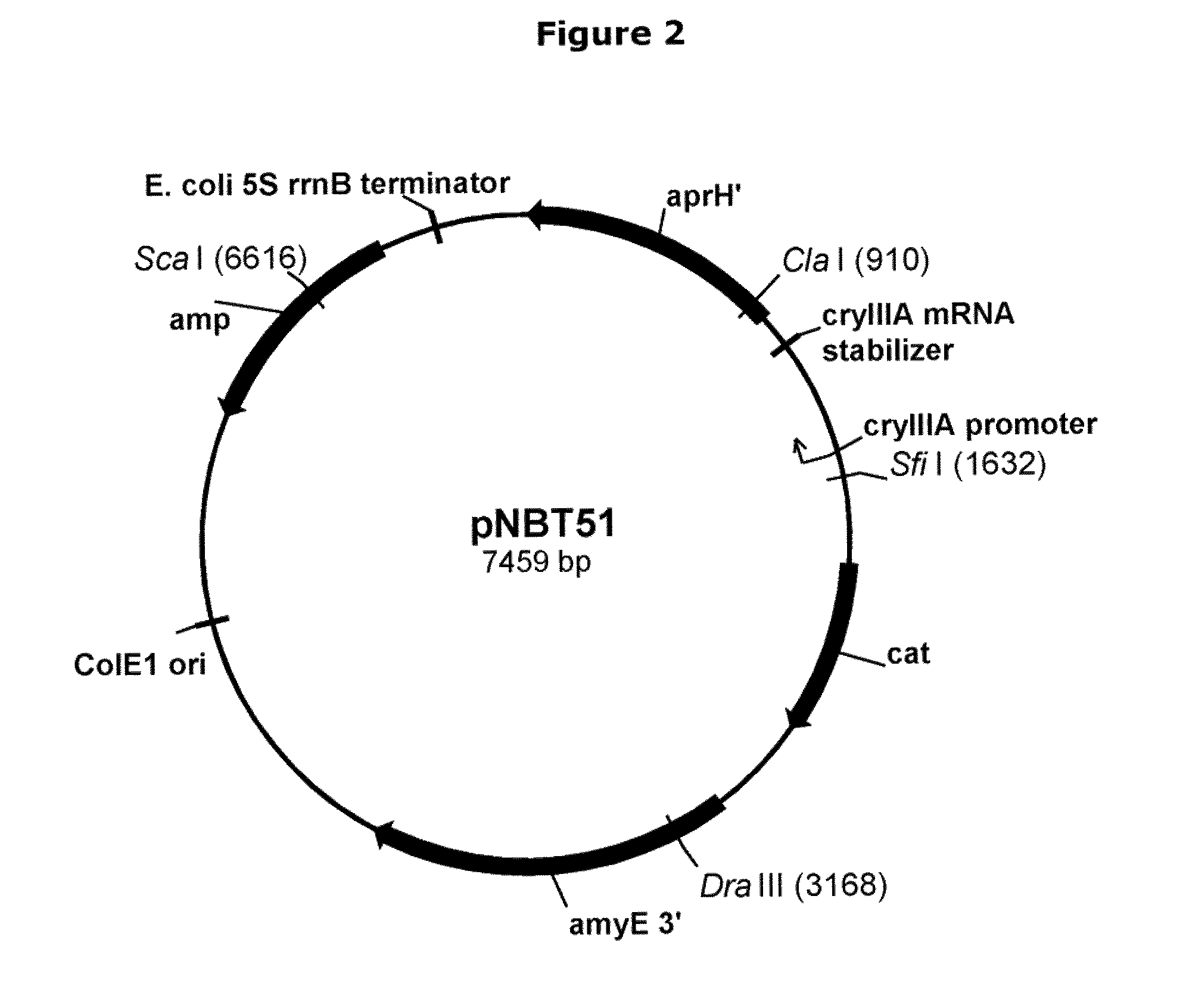Polypeptides with starch debranching activity
a technology of polypeptides and starch, which is applied in the field of polypeptides with starch debranching activity, can solve the problems of high viscosity increase, and achieve the effect of better raw starch hydrolysis
- Summary
- Abstract
- Description
- Claims
- Application Information
AI Technical Summary
Benefits of technology
Problems solved by technology
Method used
Image
Examples
example 1
Construction of pNBT36
[0104]pNBT36 is pDG268MCSΔ-PamyQ(sc) / PcryIIIA / cryIIIAstab / SAV with fragments of the Bacillus subtilis amy E gene, permitting insertion of the expression cassette at the amy E locus of the Bacillus subtilis chromosome by double homologous recombination via the two amy E fragments using chloramphenicol selection. The construction of pNBT36 is described below.
[0105]Plasmid pNBT51. Plasmid pNBT10 (pDG268MCS-PrcryIIIA / cryIIIAstab / SAV; U.S. Pat. No. 6,255,076) was isolated from E. coli host DH5α according to the manufacturer's instructions, and digested with Cla I and Sca I. The Cla I ends were blunted using Kienow fragment (New England Biolabs, Inc., Beverly, Mass., USA) and dNTPs according to the manufacturer's instructions. The digested plasmid was analyzed by 0.8% agarose electrophoresis with TBE (50 mM Tris base-50 mM boric acid-1 mM disodium EDTA) buffer, and a vector fragment of approximately 6615 bp was purified using a QIAquick Gel Extraction Kit (QIAGEN Inc...
example 2
Construction of pRB165
[0114]Plasmid pRB165 is plasmid pRB162 (pDG268MCS-PamyQ(sc) with fragments of the Bacillus subtilis pectate lyase (per) gene, permitting insertion of the expression cassette at the pel locus of the Bacillus subtilis chromosome by double homologous recombination via the two pel fragments. U.S. Patent Application publication No. 20030175902) constructed to contain a PCR clone of the spectinomycin resistance gene as described below.
[0115]Plasmid pCR2.1-spc. The spectinomycin resistance gene was amplified by PCR from plasmid pSJ5218 (U.S. Pat. No. 6,808,896) DNA using primers 994079 and 994103 (SEQ ID NO: 4 and 5). Primer 994079 incorporates a Sal I restriction site, and primer 994103 incorporates a Sfi I restriction site.
[0116]The PCR was performed according to manufacturer's recommendations described above. The PCR was performed in a RoboCycler® 40 Temperature Cycler as described above.
[0117]The resulting PCR product of approximately 1165 bp was cloned into vecto...
example 3
Construction of pMRT135
[0119]Plasmid pMRT135. Plasmid pNBT36 (pDG268Δ-PamyL4199 / PamyQ(sc) / PcryIIIA / cryIIIAstab / SAV) was digested with Sfi I and Sac I and a fragment of approximately 1337 bp bearing the triple tandem promoter was purified using a QIAquick Gel Extraction Kit. Plasmid pRB165 (pDG268Δneo-PamyQ(sc) with pel 3′, pel 5′, and spc) was digested with Sfi I and Sac I, analyzed by 0.8% agarose electrophoresis with TBE buffer, and a vector fragment of approximately 5591 bp was purified using a QIAquick Gel Extraction Kit. The pRB165 vector fragment and triple tandem promoter fragment were ligated as described above, and E. coli SURE cells were transformed with the ligation as described above, selecting for ampicillin resistance on 2×YT ampicillin plates at 37° C. Plasmid DNA was isolated from several transformants, digested with Sfi I and Sac I and analyzed by 0.8% agarose electrophoresis with TBE buffer. One plasmid with expected restriction fragments of approximately 5591 bp a...
PUM
| Property | Measurement | Unit |
|---|---|---|
| pH | aaaaa | aaaaa |
| pH | aaaaa | aaaaa |
| volume | aaaaa | aaaaa |
Abstract
Description
Claims
Application Information
 Login to View More
Login to View More - R&D
- Intellectual Property
- Life Sciences
- Materials
- Tech Scout
- Unparalleled Data Quality
- Higher Quality Content
- 60% Fewer Hallucinations
Browse by: Latest US Patents, China's latest patents, Technical Efficacy Thesaurus, Application Domain, Technology Topic, Popular Technical Reports.
© 2025 PatSnap. All rights reserved.Legal|Privacy policy|Modern Slavery Act Transparency Statement|Sitemap|About US| Contact US: help@patsnap.com



